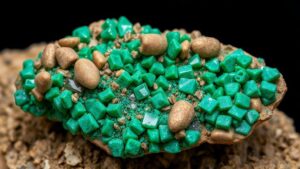Tektite Trails: Unearthing Cosmic Glass Shards from Meteorite Impacts
Tektite Trails: Unearthing Cosmic Glass Shards from Meteorite Impacts for Rockhounds and Mineral Collectors
Tektites are intriguing natural glass formed from the intense heat and pressure generated during a meteorite impact. These cosmic artifacts, which often resemble small pieces of glass or even obsidian, are not only of great scientific interest but also hold allure for rockhounds and mineral collectors. This article explores the origins of tektites, their types, and provides practical tips for collectors seeking these cosmic treasures.
The Science Behind Tektites
Tektites are believed to form when a meteorite collides with the Earth at high velocity, usually exceeding 11 kilometers per second. impact generates enough heat to melt both the meteorite and the terrestrial material below it, resulting in a molten spray that cools rapidly, forming glass. Typically, tektites range in size from a few millimeters to several centimeters, with most samples being less than 5 centimeters in diameter.
According to scientific studies, the average composition of tektites includes:
- Silicon Dioxide (SiO2) – 60-75%
- Alumina (Al2O3) – 10-20%
- Iron Oxide (FeO) – 2-12%
This composition is similar to terrestrial volcanic glass, yet differs significantly, marking their unique origins. Some tektites also contain microfossils and other inclusions, making them fascinating specimens for study.
Types of Tektites
There are several recognized types of tektites, categorized based on their geographic origin:
- Indochinites: Found primarily in Southeast Asia, these tektites are generally dark brown or black and can be elongated or irregularly shaped.
- Australites: These originate from Australia and are known for their distinctive, thin, disc-like shapes.
- Muong Nong Tektites: This subtype, also from Southeast Asia, is characterized by its thick, layered structure, often resembling a shallow dish.
- North American Tektites: Found in areas such as Chesapeake Bay, these are relatively rare and differ in appearance and composition compared to their Asian counterparts.
Each type of tektite tells a unique story about its formation and the geological activity of its surroundings, providing both aesthetic and scientific value to collectors.
Collecting Tektites: Practical Tips
For rockhounds and mineral collectors eager to add tektites to their collections, here are some practical tips to keep in mind:
- Research Locations: Familiarize yourself with regions known for tektite finds, such as the Rice Terraces in Vietnam, the landscapes of Australia, or even the impact sites in North America.
- Join a Community: Engage with local rockhounding groups or online forums to share knowledge, find potential dig sites, and learn from experienced collectors.
- Proper Tools: Equip yourself with basic tools such as a geological hammer, goggles, a fine brush for cleaning, and a magnifying glass to inspect potential finds.
- Document Your Finds: Maintain a record of where and when you found each piece. This not only helps in later study and valuation but also enriches your collections story.
Real-World Applications of Tektites
Tektites are not merely decorative items; they hold significant scientific importance. Researchers study tektites to understand the impact events that produced them, offering insights into Earths history and atmospheric conditions at the time of their formation. Also, the study of tektites has implications for planetary geology, as it provides clues about conditions on other celestial bodies with similar impact histories.
Also, tektites have been used as educational tools in geology and planetary science courses, helping students to grasp concepts of meteorite impacts and the natural processes that shape our planet.
Actionable Takeaways
To wrap up, tektites are enchanting remnants of cosmic history that captivate both amateur and seasoned mineral collectors. By understanding their origins, types, and the practical aspects of collecting, enthusiasts can successfully embark on their own journey of discovery. As you venture out to hunt for these otherworldly treasures, remember the scientific significance they hold, and treasure the stories they tell from beyond our planet.



